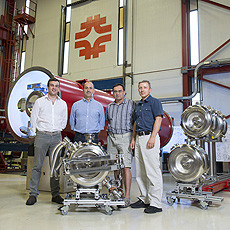Successful test of single-spoke cavity gives SSR1 team a reason to smile
 |
| Donato Passarelli, Leonardo Ristori, Sergey Kazakov and Oleg Pronitchev, all of the Technical Division, stand next to the recently tested SSR1 cavity. Photo: Reidar Hahn |
Eight cavities might sound like a nightmare to the average person. But when it comes to speeding up particles, it's an aspiration.
In July, a team of scientists and engineers finished designing, building and testing the first of a series of eight special cavities for the planned PIP-II project. All components of the cavity were designed at Fermilab and were built in U.S. industry. The team anticipates completing and testing all eight cavities, plus two cavities received by Indian collaborators, by summer 2016.
The cavities will fit into the first single-spoke resonator cryomodule, SSR1, to be tested with particle beam in the next few years. Altogether the PIP-II project would require 116 cavities of five different types to propel protons to 800 MeV, or 84 percent the speed of light.
"This milestone is exciting because it was really the last step in R&D for this type of cavity," said Leonardo Ristori, task manager for the spoke resonator section of PIP-II. "We spent all these years designing, building and testing prototypes. Now we feel comfortable that we can produce these single-spoke cavities."
Not to be confused with the painful tooth decay that comes from eating too much sugar, accelerator cavities are meticulously designed metal structures, pumped with radio-frequency power, that give particles a boost using rapidly oscillating electric fields.
SSR1 cavities are cylindrical, about the size and build of car tires. They are called "single-spoke" because individual cavities are divided by a hollow hourglass-shaped partition that resembles the spoke of a wheel. They are fashioned from pure niobium, a superconducting metal that, when kept under 9.3 Kelvin (or minus 443 degrees Fahrenheit), presents no electrical resistance when a voltage is applied.
The most recent cavity test simulated the configuration of the full SSR1 cryomodule using the same pieces that would be used in the PIP-II superconducting linac. In this integrated test, the team tested the performance of the power coupler and the frequency-tuning system, making sure they didn't interfere or degrade the performance of the cavity. The team was interested in measurements of how large of an accelerating electric field the cavity could support, called the gradient, and how efficiently it uses the power put into it, referred to as the quality factor.
Ristori said that the cavity, the coupler and the tuner all passed the tests, meeting and exceeding project requirements.
One of the main challenges in designing the cavity was desensitizing it to helium pressure variations and other sources of vibration. This was for the most part achieved by developing a state-of-the-art, self-compensating behavior.
"This is an encouraging result," Ristori said. "Everybody did an excellent job in each portion, and it all came together. It motivates the team to move forward and push the design to the limits for the other sections of the planned accelerator."
Once all eight are complete, the team will assemble the SSR1 cryomodule in Lab 2, where they are currently installing cleanrooms. It will be the first spoke cryomodule ever completed in the United States.
"It's our first fully equipped cavity, tested at full power for PIP-II," said Slava Yakovlev, head of the SRF Development Department. "We will use all the lessons we learned from this cavity in order to develop and build all the other cavities in the project and put them into operation."
—Ali Sundermier
|